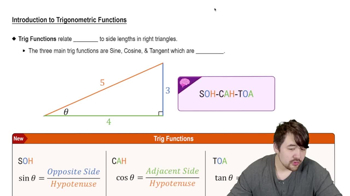Table of contents
- 0. Functions7h 52m
- Introduction to Functions16m
- Piecewise Functions10m
- Properties of Functions9m
- Common Functions1h 8m
- Transformations5m
- Combining Functions27m
- Exponent rules32m
- Exponential Functions28m
- Logarithmic Functions24m
- Properties of Logarithms34m
- Exponential & Logarithmic Equations35m
- Introduction to Trigonometric Functions38m
- Graphs of Trigonometric Functions44m
- Trigonometric Identities47m
- Inverse Trigonometric Functions48m
- 1. Limits and Continuity2h 2m
- 2. Intro to Derivatives1h 33m
- 3. Techniques of Differentiation3h 18m
- 4. Applications of Derivatives2h 38m
- 5. Graphical Applications of Derivatives6h 2m
- 6. Derivatives of Inverse, Exponential, & Logarithmic Functions2h 37m
- 7. Antiderivatives & Indefinite Integrals1h 26m
- 8. Definite Integrals4h 44m
- 9. Graphical Applications of Integrals2h 27m
- 10. Physics Applications of Integrals 2h 22m
1. Limits and Continuity
Finding Limits Algebraically
Problem 4f
Textbook Question
Limits and Continuity
Suppose the functions ƒ(x) and g(x) are defined for all x and that lim (x → 0) ƒ(x) = 1/2 and lim (x → 0) g(x) = √2. Find the limits as x → 0 of the following functions.
f. [ƒ(x) • cos x ] / x―1
 Verified step by step guidance
Verified step by step guidance1
First, identify the limit expression you need to evaluate: lim (x → 0) [ƒ(x) • cos x] / (x - 1).
Recognize that the limit involves a product of functions and a division. We can use the limit properties to separate the functions: lim (x → 0) [ƒ(x) • cos x] / (x - 1) = lim (x → 0) [ƒ(x) • cos x] / lim (x → 0) (x - 1), provided the limits exist and the denominator is not zero.
Evaluate the limit of the numerator: lim (x → 0) [ƒ(x) • cos x]. Since lim (x → 0) ƒ(x) = 1/2 and lim (x → 0) cos x = cos(0) = 1, use the product rule for limits: lim (x → 0) [ƒ(x) • cos x] = (1/2) • 1 = 1/2.
Evaluate the limit of the denominator: lim (x → 0) (x - 1). This is a straightforward limit: lim (x → 0) (x - 1) = 0 - 1 = -1.
Combine the results from the numerator and denominator: lim (x → 0) [ƒ(x) • cos x] / (x - 1) = (1/2) / (-1) = -1/2. Therefore, the limit is -1/2.
 Verified video answer for a similar problem:
Verified video answer for a similar problem:This video solution was recommended by our tutors as helpful for the problem above
Video duration:
2mPlay a video:
Was this helpful?
Key Concepts
Here are the essential concepts you must grasp in order to answer the question correctly.
Limits
Limits are fundamental in calculus, representing the value that a function approaches as the input approaches a certain point. In this question, understanding how to evaluate limits as x approaches 0 is crucial, especially when dealing with functions that may not be defined at that point. The limit helps in determining the behavior of the function near that point, which is essential for solving the problem.
Recommended video:

One-Sided Limits
Continuity
A function is continuous at a point if the limit of the function as it approaches that point equals the function's value at that point. In this context, continuity ensures that the functions ƒ(x) and g(x) behave predictably around x = 0, allowing us to apply limit properties effectively. Understanding continuity helps in analyzing the behavior of composite functions, especially when limits are involved.
Recommended video:

Intro to Continuity
Trigonometric Limits
Trigonometric limits, such as those involving cos(x), are important in calculus as they often appear in limit problems. The limit of cos(x) as x approaches 0 is 1, which simplifies the evaluation of limits involving trigonometric functions. Recognizing these standard limits allows for easier manipulation and calculation of more complex expressions, such as the one presented in the question.
Recommended video:

Introduction to Trigonometric Functions

 5:21m
5:21mWatch next
Master Finding Limits by Direct Substitution with a bite sized video explanation from Callie
Start learningRelated Videos
Related Practice







